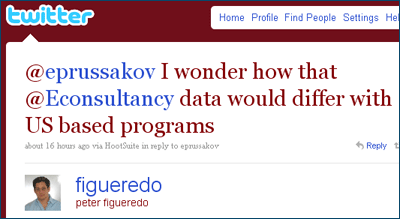 Yesterday Matt Swan of Affiliate Window has published an Econsultancy.com post with some interesting data on the changes in affiliate promotional methods they’ve registered at Affiliate Window apparently predominantly in the UK.
Yesterday Matt Swan of Affiliate Window has published an Econsultancy.com post with some interesting data on the changes in affiliate promotional methods they’ve registered at Affiliate Window apparently predominantly in the UK.
Having analyzed the top 20 affiliates in their affiliate network, and relying on affiliate self-categorization, they have noticed the following:
In January 2005 13 of the top 20 affiliates were classified as PPC affiliates. By January 2011 only three affiliates listed in the top 20 stipulated their primary promotional method as PPC.
Conversely, vouchercode sites did not generate a significant amount of volume until 2006. By January 2007 three vouchercode affiliates were listed within the top 20 across the network. Similarly, the increase in the number of sales through cashback sites has seen the number of affiliates in the top 20 more than triple from two in Jan 2005 to seven in Jan 2011. [source]
Interesting post and data (and certainly some interesting comments under it too), but yesterday after tweeting about this article, I liked this train of thought:
So today I took my time to analyze data on the top 30 publishers within a well-established Commission Junction-based affiliate program, and here’s the chart I’ve arrived at:
A bit of clarification: I looked at the period of 10/1/2010-1/31/2011, and this merchant is an Internet retailer who sees a significant revenue boost in pre-Christmas and post-Christmas sales. So, the numbers for other types of advertisers may be somewhat different.
Also, as you can see, I added one more category to the Affiliate Windows’ ones — datafeed affiliates (or those who build websites based on merchant product datafeeds).
Finally, as I was performing my brief analysis, I couldn’t help but take note of the following observations:
- Many of these affiliates cannot be classified as one pure type. For example, there are some that offer both coupons and cashback, others that produce content and employ feeds (or coupons), yet others who use both datafeeds and coupons.
- At least one-quarter of these top affiliates run their PPC ad-to-affiliate site campaigns. How do we categorize affiliates that run their own content, coupon, or datafeed-based websites, but rely heavily on paid search as well?
What do you see in the affiliate programs you manage (if you’re a manager) or across affiliates that operate on your network (if you’re an affiliate network rep reading this)? Do you think the tendency for coupon-oriented affiliates to take the majority of the pie will continue to develop? I’d love to hear your thoughts on the subject. Please use the “Comments” are below for this, and many thanks in advance for your participation.


Affiliates primarily promote one product through our in-house program. (It’s the foundation of our other products). Due to the nature of the product, a higher degree of preselling based on experience with/knowledge of the product directly impacts conversion rates. Coupon and datafeed strategies are not available.
Two years ago, affiliates primarily used content and PPC strategies. PPCers mainly drove traffic to product reviews, content with added bonuses/incentives and other preselling content. More recently, changes in keyword trademarking have reduced the number of PPCers leaving a strong majority as “content affiliates” which includes using social media (also content). A small percentage run their PPC ad-to-content site campaigns.
Currently, content continues to have a strong presence with top affiliates also reiterating the fact that “content remains king”, as Matt noted in his article referenced above.
As to how to categorize affiliates that run their own content, coupon, or datafeed-based websites, but rely heavily on paid search – I think of them as “diversified affiliates”.
Erin
I like the “diversified affiliates” idea, Erin. While this wouldn’t help pinpoint the exact primary method of promotion, it will definitely be the right way to categorize them.
Thank you also for sharing your observations as far as the types of affiliates that are most productive in your program (one very different from the program that I’ve analyzed, yet very similar to what other people may be doing). For a product like yours content-producing affiliates should indeed be one of the most promising groups/types of affiliates out there.
In the software vertical where I work in, we noticed a strong increase in the revenue driven by coupon affiliates in the last 2 years.
And, like you said, don’t think they only have coupons on their websites – many of them are download portals that also offer coupons or software niched websites (e.g. focusing on DVD burners, video tools etc.).
As another tendency, we also have more affiliates using datafeeds to populate their websites.
I personally think the usage of coupons throughout the affiliate world will become a must have for best performers, since coupons help increase the conversions. Big affiliates will continue to ask for exclusive coupons and offer other things to the potential buyers (such as reviews, for example), to differentiate themselves.
And let’s not forget about trust, which is and will also be a major factor that influences the purchase decision. I’d rather buy something from Amazon without a coupon than buy it from an unknown website with 10% off, even if that website is on the first page of search results in Google 🙂
I do agree with Cristian